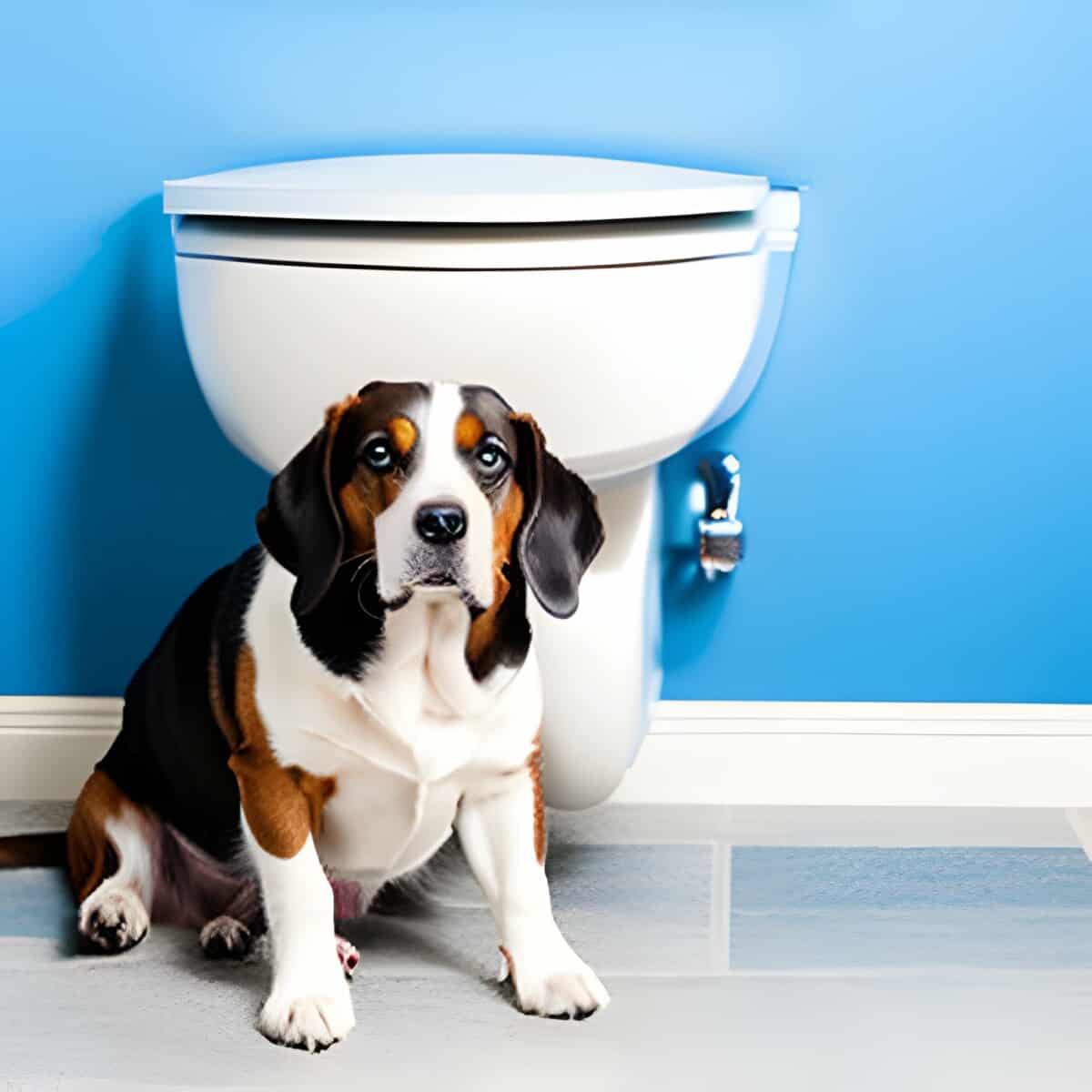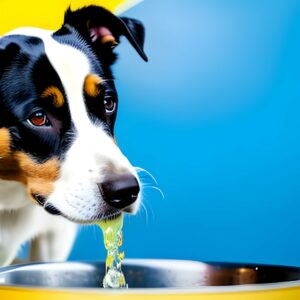One of the most challenging issues you may face as a pet owner of an older dog is incontinence.
However, incontinence is never normal for old dogs or dogs of any age, and it is not a normal sign of aging in dogs.
This condition can manifest in various ways, but it often involves your furry friend having accidents indoors, which can be frustrating for both of you.
Managing old dog incontinence is possible with the right knowledge and strategies.
In this article, we will provide you with medical conditions related to incontinence and tips for managing incontinence in senior dogs.
Old Dog Incontinence: Table of Contents
Signs and Symptoms of Incontinence in Old Dogs
To recognize incontinence, look for symptoms:
- Frequent accidents indoors
- Inability to hold urine for an extended period
- Excessive licking of the genital area
- Strong-smelling urine
You may notice your dog drinking more water than usual or experiencing discomfort while urinating. Some dogs may become lethargic or show signs of depression if they are struggling with incontinence.
Incontinence is a common symptom of health issues related to urinary and bladder organs, hormones, neurological issues, and cancers.
Understanding Old Dog Incontinence
Incontinence refers to the lack of bladder and bowel control that can cause your dog to have accidents indoors. This condition is commonly associated with senior dogs, but it can happen to dogs of any age.
Old dog incontinence can be caused by:
- Urinary tract infections
- Bladder stones
- Weak bladder muscles
- Hormonal imbalances
- Neurological issues
- Kidney disease
- Cancer
1. Incontinence and UTI in senior dogs
Urinary incontinence and urinary tract infections (UTIs) can both occur in senior dogs, and there may be a correlation between the two conditions.
UTIs can cause discomfort and pain in your dog, and can also lead to more serious health problems if left untreated.
To diagnose a UTI in dogs, a veterinarian will typically perform a physical examination that includes checking the kidneys and bladder.
A sterile urine sample from your dog is tested for bacteria and other parameters,
The procedure called cystocentesis, which involves inserting a needle directly into the bladder to collect urine is sometimes performed if the sample cant be collected otherwise.
Symptoms of a UTI in dogs can include:
- frequent urination,
- straining to urinate,
- blood in the urine
- incontinence,
Treatment for a UTI in senior dogs typically involves a course of antibiotics to clear up the bacterial infection, as well as supportive care to manage any pain or discomfort your dog may be experiencing.
2. Incontinence and Bladder Stones in senior dogs
Bladder stones are made up of minerals that clump together in the bladder and can take weeks to months to develop.
The most common types of bladder stones in dogs are:
- struvite
- calcium oxalate,
- urate bladder stones
Senior dogs, male dogs, and neutered dogs are at greater risk of developing calcium oxalate stones, which are also the most recurring type of bladder stones
Symptoms of bladder stones in dogs can include:
- frequent urination,
- blood in the urine,
- straining to urinate,
- discomfort while urinating,
- incontinence
If bladder stones are suspected in a senior dog, a veterinarian may identify most bladder stones in dogs through an X-ray or abdominal ultrasound.
The vet may also want to submit urine for analysis and culture for bacteria because tumors and infections may cause similar symptoms as bladder stones.
There are three main treatment options for bladder stones in dogs:
- surgical removal,
- non-surgical removal by urohydropropulsion,
- dietary dissolution.
The specific treatment that is recommended for a senior dog will depend on the type of stone that is present and will require a veterinarian’s supervision.
3. Incontinence and Weak bladder muscles (USMI) in senior dogs
Weak bladder muscles, also known as urethral sphincter mechanism incompetence (USMI), can lead to urinary incontinence, where a dog leaks urine when they are relaxed or asleep.
Dogs with weak bladder muscles may also have accidents inside the house and may need to urinate more frequently
Causes of weak bladder muscles in senior dogs.
- Diabetes,
- kidney failure,
- hyperthyroidism,
- Cushing’s disease
- Ectopic ureters,
Treatment for weak bladder muscles in senior dogs often involves medication to improve bladder tone and help the dog maintain control of their urine.
Hormone replacement therapy may also be recommended.
In some cases, surgery may be necessary to correct the underlying cause of the incontinence.
4. Incontinence and Hormonal Imbalances in senior dogs
Hormonal imbalances can affect the muscles that control the bladder, leading to urine leakage.
Fortunately, most canine endocrine diseases are treatable or manageable with medication
A veterinarian can perform a blood test to check hormone levels and determine appropriate treatment.
Hormone replacement treatment may be necessary for dogs with hormonal imbalances, but these pets must be monitored for adverse effects and periodically retested to ensure proper dosing.
Benign hyperplasia, a variation of normal physiologic manifestations in dogs and men, can occur in intact male dogs and result from hormone imbalances. This condition is usually seen in dogs older than 4 years of age and causes an enlargement of the prostate gland.
Estrogen is one of the hormones that may be used in hormone therapy for incontinent senior female dogs. It is important to note that hormone therapy should only be administered under the guidance of a veterinarian and may not be appropriate for all dogs.
There are other treatments available for incontinence in senior dogs, such as the use of medications like phenylpropanolamine (PPA).
Endocrine disorders, such as thyroid disorders and Cushing’s disease, can affect hormone levels in senior dogs
These imbalances can cause symptoms such as skin issues, weight gain, and changes in behavior.
5. Incontinence and Neurological Issues in senior dogs
Neurological causes of incontinence can include:
- spinal injuries,
- disruption of the nerves controlling the bladder,
- brain diseases or lesions
If your senior dog is exhibiting signs of:
- urinary incontinence, such as involuntary loss of urine,
- difficulty walking,
- changes in how their tail is carried,
seek veterinary care.
A neurogenic bladder in dogs can also be a cause of incontinence and uncontrolled voiding. Symptoms of a neurogenic bladder in dogs can include incontinence, difficulty urinating, and frequent urination.
If your senior dog is experiencing incontinence due to neurological issues, your veterinarian may recommend medication, surgery, or physical therapy, depending on the specific case.
6. Incontinence and Kidney Disease in senior dogs
Diseases of the urinary tract in dogs that can have similar symptoms but are less common include:
- pyelonephritis (kidney infection),
- kidney stones,
- proteinuria,
- neurologic conditions affecting the urinary bladder (atony),
- problems of the ureters or urethra (e.g., strictures, diverticulum).
The severity of kidney disease can be classified into four stages, with stage 1 being the mildest and stage 4 being the most severe.
The symptoms of kidney disease in dogs can vary depending on the stage of the disease and can include:
- decreased appetite,
- vomiting,
- lethargy,
- increased thirst and urination.
Treatment for kidney disease in senior dogs typically involves fluid therapy, which is administered intravenously at a veterinary clinic over the course of several hours.
This helps to rehydrate the dog and flush out any waste products that the kidneys are not filtering properly. In some cases, medication may also be needed to stimulate urine output.
The age of onset of kidney disease is often related to the size of the dog, with small dogs experiencing early signs at about ten to fourteen years of age, while large dogs have a shorter lifespan and may develop the disease earlier.
Some of the senior dogs’ nephrons, the functional units of the kidneys, may die, leading to reduced kidney function.
7. Incontinence and Cancer in senior dogs
Vets can perform a urine sample test to check for the presence of cancer cells in the bladder, known as the Veterinary Bladder Tumor Antigen Test (VBTA).
If your veterinarian suspects intestinal disease as the cause of your senior dog’s bowel incontinence, the first diagnosis tests typically include a fecal parasite examination and blood tests, including a complete blood cell count, serum biochemistry, and perhaps additional specialized gastrointestinal blood tests.
In dogs, prostate cancer is rare, but it can occur, and the only way to confirm the diagnosis is through a biopsy of the prostate.
How Aging Affects a Dog’s Bladder Control
Bladder muscles in senior dogs may weaken, making it harder for them to hold their urine for extended periods. Theys may have health issues that affect their bladder function or mobility, making it difficult for them to get outside or access their pee pads in time.
Home Management Strategies
Alongside veterinary treatment, you can implement home management strategies to support your dog’s overall health and improve their quality of life. These strategies not only help your dog manage their incontinence but also create a comfortable and safe environment for them to thrive in.
Creating a Comfortable Environment for Your Incontinent Dog
When dealing with incontinent dog, a comfortable environment means ensuring that your dog has easy access to their water bowl, food, bed, and any pee pads or diapers you’re using to manage their incontinence. A comfortable environment will help your dog feel safe and secure, reducing their stress levels.
Improving their overall health
Incontinence can cause skin irritation and infections, so keep your dog’s living area as clean and dry as possible. Regularly change their bedding, and clean any soiled areas with an enzyme-based cleaner to prevent bacteria and odors from building up.
Using Dog Diapers and Pee Pads
If your dog struggles with holding their urine consistently, you can use dog diapers or pee pads to keep your home clean and your dog comfortable.
These products are designed to absorb urine and prevent it from leaking onto your floors and furniture.
When using dog diapers or pee pads, change them regularly and clean your dog’s genital area to prevent infections.
Cleaning and Deodorizing Tips
When cleaning up after your dog, use an enzyme-based cleaner that will break down the proteins in urine and feces, eliminating odors and preventing your dog from being attracted back to the same spot.
Avoid using ammonia-based products as they can attract dogs to revisit those spots. Instead, opt for a pet-specific cleaner that is safe for your dog and effective at removing stains and odors.
Diet and Nutrition for Senior Dogs
Senior dogs need a balanced and age-appropriate diet. Some dog foods are specially formulated to support bladder health and can be beneficial for dogs with incontinence issues
Consider adding supplements to support bladder function, such as cranberry supplements. Cranberry supplements are a natural way to prevent urinary tract infections, which can lead to incontinence.
We created a complete guide to senior dog nutrition: A complete guide to senior dog nutrition
We also listed great food options:
Best wet dog food for senior dogs
And you may also want to read:
Best senior dog supplements
Exercise and Mental Stimulation for Aging Dogs
Keeping your dog active and engaged is great prevention from developing immobility issues that can exacerbate incontinence.
Exercise helps maintain your dog’s overall health and a healthy weight.
It’s also important to provide your dog with opportunities for mental stimulation to keep their minds sharp and engaged. Mental stimulation can include activities such as puzzle toys, training exercises, and interactive playtime with their owner.
When to Seek Professional Help
When symptoms include:
- Constant wetting
- Blood in the urine
- Difficulty urinating or defecating
- Excessive thirst or appetite
These symptoms may indicate more severe underlying health conditions that require immediate attention. If you notice any of these symptoms, contact your veterinarian right away.
Diagnostic Tests for Incontinence
Your veterinarian may perform diagnostic tests to determine the underlying cause of your dog’s incontinence. These tests may include:
- Urinalysis to assess the urine’s color, clarity, and composition
- Blood work to evaluate your dog’s overall health and identify underlying medical issues
- Imaging scans, such as X-rays or ultrasound, to assess your dog’s bladder and urinary tract
Depending on the underlying cause of the incontinence, your veterinarian may recommend dietary changes, medication, or surgery as a treatment option.
Treatment Options for Old Dog Incontinence
- Medications to strengthen the bladder muscles and improve bladder control
- Hormone replacement therapy to address hormonal imbalances that may be contributing to the incontinence
- Surgery to address underlying medical issues, such as bladder stones or tumors
- Home management strategies to support your dog’s health, such as frequent potty breaks, providing easy access to water, and using absorbent pads or diapers
Preventative Care for Senior Dogs
Scheduling regular visits with your veterinarian is crucial to addressing underlying health issues on time. Preventative care can help you detect issues early and prevent them from developing into severe conditions.
Old dog incontinence takeaways
Managing old dog incontinence may seem daunting, but it is entirely possible with the right strategies in place. Consult your veterinarian, implement home management strategies, and support your dog’s overall health to manage incontinence and give your furry friend their best life.
By taking a proactive approach to your dog’s health, you can help them live a happy and comfortable life, even with incontinence. With a balanced diet, regular exercise, and preventative care they can continue to enjoy their golden years with you by their side.
My Senior Paws is a participant in the Amazon Services LLC Associates Program, an affiliate advertising program designed to provide a means for sites to earn advertising fees by advertising and linking to Amazon.com. We also participate in other affiliate programs which compensate us for referring traffic.




